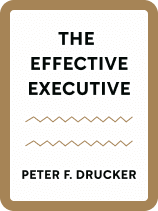

This article is an excerpt from the Shortform book guide to "The Effective Executive" by Peter F. Drucker. Shortform has the world's best summaries and analyses of books you should be reading.
Like this article? Sign up for a free trial here .
What is strength-based management? How can you maximize the strength of your employees to boost the performance of your organization?
Strength-based management is a management style that is focused on the strengths of the employees. According to management consultant Peter Drucker, maximizing strengths —your own strengths and the strengths of those around you—is more effective than trying to fix weaknesses.
Here is why to increase the effectiveness of your organization, it’s important to build the strengths of those around you, as well as your own.
What Is Strength-Based Management?
You can’t accomplish anything significant by focusing on your own or others’ weaknesses. When you focus on weaknesses, you undermine the purpose of the organization, which is to translate people’s strengths into performance for results. He says that morally, managers owe it to the organization to maximize the strength of every employee, and owe it to employees to enable them to excel to the extent possible.
| What Is a Strength-Based Management Approach? The Gallup organization popularized strength-based development for performance management and leadership development in 2001, although the idea arose in the 1980s as an approach to social work. Embraced by HR professionals and big companies, it launched the trend of strengths coaching. Gallup defines strengths as a person’s unique combination of talents, abilities, and motivators, apart from competencies. Strengths-based development helps employees understand and leverage their capabilities; it focuses on what they do well rather than what they do poorly, or on maximizing strengths rather than improving weaknesses. Focusing on Employees’ Strengths Pays Off Gallup says its research over 40 years shows that when employers focus on workers’ strengths rather than trying to fix weaknesses, they have better employee engagement, performance, retention, customer engagement, and profitability. In fact, a recent Gallup study found that businesses saw as much as a 30% increase in profits when they focused on strengths-based development. The Counterpoint A 2016 Harvard Business Review article argues that strengths development has gone too far and weakens organizations. When it comes to leadership development, author Tomas Chamorro-Premuzic, a professor of business psychology, argues:There’s no scientific evidence that strengths development is better at improving performance than traditional feedback.It can make people feel more competent than they really are.It results in resources being wasted on lesser performers rather than spent on the top 20% of people responsible for 80% of productivity.Overused strengths become liabilities. (Confidence can turn into overconfidence, and so on.)Strengths training doesn’t address the real problem: incompetent leaders and disengaged employees. |
Hiring and Staffing for Strength
Companies often try to minimize weaknesses in the organization by hiring or promoting the person with the fewest weaknesses. However, Drucker argues that this results only in mediocrity. Instead, he says, you should fill positions based on what a person can do.
Start by hiring for strength—ask a candidate what she does extremely well. Look for excellence in one key area relevant to the organization, where excellence will make a significant difference, rather than adequacy in all areas. Once you’ve hired for strength, build on it by demanding performance—that is, demand that the person do what she should be able to do well.
Steps to Maximize Employee Strength
In addition to hiring talented people, Drucker recommends putting current employees in roles that maximize their strengths. He outlines several steps:
1) Make sure the job is realistically designed: Many jobs are designed for a perfect person, so no one measures up. Signs that you’ve created an impossible job include requiring someone with a mix of temperaments (such people don’t exist) and making several hires with good track records who then fail in the job. (Shortform note: Examples of ludicrously unrealistic job postings still abound. Reasons that employers write unrealistic job descriptions include inexperience at posting jobs, hoping unrealistically for a perfect candidate, or just going through the motions to meet a requirement when they already have an internal candidate.)
2) Make the job big and challenging: A job has to be demanding enough to bring out a person’s strength, and also big enough that applying a relevant strength will significantly impact the organization’s performance. In contrast, Drucker says most organizations create small jobs to fit a person or moment, but the person no longer fits when the organization’s needs change. A person can only meet the challenge of new demands when the job is demanding to begin with. (Shortform note: Some ways to motivate employees by making work challenging include offering new experiences, and (counterintuitively) giving people projects they don’t like that force them to use and learn new skills.)
3) Appraise people for strengths: Most company appraisal processes focus on what’s wrong with people rather than their strengths. This ruins a manager’s relationship with employees. The purpose of an appraisal should be to understand strengths and how you can build on them. Start by establishing the major contributions expected from the person, and how her performance has matched them. Then ask:
- What has she done well? What is she likely to do well in the future?
- What does she need to learn in order to maximize her strength?
Drucker contends that these questions actually prompt a more critical appraisal than the typical process does. By starting with what a person can do, this approach views weaknesses as limitations on the full use of the person’s strengths or on their effectiveness.
| Creating a Strengths-Based Performance Appraisal Marcus Buckingham, author of the original edition of First, Break All the Rules, offers tips in a Harvard Business Review article on creating a strengths-based appraisal system, which he calls future-focused coaching (as opposed to feedback on past performance):It must be a real-time system focused on coaching in the moment (at least weekly), rather than a once-a-year review.It must be about the individual and driven by them (where am I and how can I get better?).It must be based on strengths, not remediation. Weaknesses offer the least potential for growth.It must be simple and straightforward, asking just two questions: What are you going to get done this week, and what help do you need?It must be a “local” system, not a centralized system flowing from company goals. |
Maximize Your Boss’s Strength
In addition to leveraging the strength of your employees, Drucker says you should do the same with your boss. He claims that “managing up” in this way is smart for two reasons:
- A successful, promotable boss increases your chances of success. For example, she has the ability to mentor you and promote your career interests.
- Maximizing your boss’s strength strengthens the organization, and it frees you to focus on your contribution. (An insecure or weak boss creates more work for you and distraction.)
(Shortform note: Managing up is typically defined more broadly as keeping the boss happy or having a good relationship with your boss. A Harvard Business Review article discusses scenarios in which managing up is particularly useful, including getting along with an insecure or indecisive boss.)
How to Manage Your Boss
According to Drucker, you don’t build your boss’s strengths by currying her favor. Instead, ask yourself the same questions you ask about your employees: What does she do really well? What does she need from me in order to build this strength? Then, provide it. For example, if your boss is great at representing the company positively in the community and schmoozing with local leaders, use your network contacts to create more opportunities to do so.
Drucker says you can also help your boss perform better if you understand and work with her preferred way of processing information. When you present an issue in a way that’s accessible to your boss, she can effectively apply her strength to a solution. People may be either “listeners” or “readers.” Listeners pick up cues and information from listening to others; readers get their information from reading. Don’t give a listener a detailed report to read, or talk to a reader about a report before she’s had a chance to read it.
Additionally, some people prefer seeing a summary; others want to know the full thought process behind a recommendation. Some want the earliest details; others don’t want to hear about an issue until the options have been fully developed. (Shortform note: Similarly, some bosses have distinct email preferences: Some prefer emails over phone calls or meetings; others don’t want you cluttering up their inboxes.)
Maximize Your Strength
In addition to building on your employees’ and boss’s strengths, Drucker recommends also maximizing your own strength to produce results.
While most people think they know their strengths, Drucker says they’re often wrong. To determine your strengths, he recommends analyzing your performance to see what comes more easily to you than to others.
(Shortform note: In the 2005 article cited earlier in this section, Drucker was a bit more specific. He advised determining your strengths by collecting feedback. When you make an important decision or take action, write down what you expect will happen; compare expectations with results six to 12 months later to see where you were on point. This will show you your areas of strength (what you got right) and weakness (what you got wrong). Alternatively, you can use Gallup’s StrengthFinder. Once you know your strengths, find ways to continually improve on and expand them.)
To further leverage your strengths, know your most productive work style and use it. Know whether you’re a listener or reader, whether you work best on a committee or alone, in the morning or evening, or from an outline or just rough notes. Use your work habits to enhance your effectiveness
In summary, build on what you know you can do, and do it in the way you know you do best.
Focus on Opportunities, Not Problems
Drucker wraps up his discussion of practice #4 with tips repeated elsewhere. But one tip for leveraging your strengths has proven to be especially durable: Drucker himself repeated it numerous times over the years, and it’s often quoted by others:
- “Feed” opportunities and “starve” problems in your organization by focusing your attention and resources on the opportunities, especially when it comes to people. View people, including yourself, as opportunities.
His point is that many businesses do the opposite—but that addressing problems (weaknesses) doesn’t increase performance and produce results. Only applying strengths to opportunities does that.
| How to Become Opportunity-Focused Drucker doesn’t offer specific advice in The Effective Executive on how to become opportunity-focused. But in a 2004 article, he reiterated that while problems need to be addressed, doing so only prevents damage; in contrast, only capitalizing on opportunities leads to results. The keys to being opportunity-focused are to prevent problems from overpowering opportunities, assign your best people to work on opportunities, and focus meetings on opportunities over problems. Note that the typical SWOT analysis of strengths, weaknesses, opportunities, and threats, which is often used in strategic planning, implies applying equal attention to opportunities and problems; however, Drucker argues that you should apply the bulk of your thought and resources to opportunities. Drucker advocated always treating change as an opportunity. He identified the following change scenarios as presenting opportunities:A surprising success or failure in your business, a competitor’s, or in the industryA gap between current and potential results in a market, process, product, or service—for example, you may have a larger than “normal” gap between the number of cold calls you make and the number of positive responses. This suggests an opportunity to generate more positive responses by changing your qualifying process.An innovation or technological advance in a relevant process, product, or serviceChanges in industry or market structureChanging demographics (for instance, millennials becoming established in their careers and increasing their buying power) |

———End of Preview———
Like what you just read? Read the rest of the world's best book summary and analysis of Peter F. Drucker's "The Effective Executive" at Shortform .
Here's what you'll find in our full The Effective Executive summary :
- How to manage yourself before you can manage others
- The five practices that anyone can learn to be more effective
- Why leaders should purposely create disagreements






